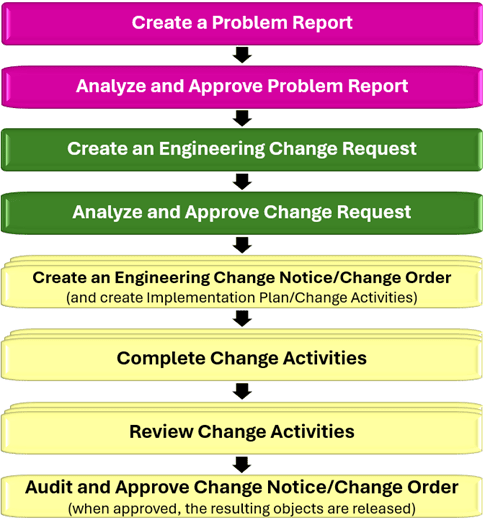Engineering Change Management is the business process of controlling product change and implementation. Engineering Change Management processes within Product Lifecycle Management (PLM) software are a core component of our PLM custom training offerings and one of my favorite topics. In this blog, I'd like to share a general workflow—independent of the PLM software used—that highlights key Engineering Change Management concepts for those who are new to the field. You can then test your knowledge by taking the quiz found in my Engineering Change Management Quiz blog. For those of you who live and breathe Engineering Change Management, feel free to go directly to the quiz after a quick review!
Shown in the image below is the entire Engineering Change Management process. Depending on your role in Engineering Change Management, you may participate in only certain parts of the process. Your tasks may involve reviewing, authoring, or approving product data.

The overall Engineering Change Management process typically starts with the creation of a Problem Report, which is a request for a product change due to an issue or enhancement logged on behalf of a customer or supplier. However, this step can also be optional. The creation of the Problem Report involves entering details such as the priority, affected object (s), suggested solution, and expected benefit. The Change Administrator or Problem Report Reviewer then investigates the issue and conducts an impact analysis, when applicable. Once the Problem Report is approved, the process can move forward to the creation of a new Change Request.
A formal change is proposed by creating a new Change Request for the affected object. The information from the Problem Report is carried over to the Change Request and can be updated as needed before being submitted for analysis. The Change Request is then analyzed, including validation of the request, coordination of the technical analysis, and generation of a recommended solution. The relevant analysis information is also included with the Change Request. At this point, the Change Request can either be rejected without further review or proceed with the process. Depending on your PLM system configuration, there may be a fast-track option that skips the review by the Change Review Board. Once the Problem Report is approved, the process can move forward to the creation of a new Change Notice, also known as a Change Order.
When the Change Request is approved, the appropriate Change Notice is created, and a plan to implement the approved Change Request is formulated. The implementation plan consists of Change Activity/Action tasks required for the work. The Assignees (sometimes referred to as Responsible Engineers, depending on the PLM system) then complete the assigned Change Activities/Actions, such as editing or creating specification documents, CAD models, and/or EBOMs. Before the tasks are marked as complete, the Reviewer must check and verify the work of the Assignees. Once all tasks associated with the Change Notice are completed, the changes are audited to ensure that the resulting documentation is clear, concise, and valid. The Change Notice is then either approved or rejected. If approved, the resulting object(s) are released, and the corresponding Change Request is considered resolved and closed. With the resulting object(s) released, the Engineering Change Management process is complete.
---------------------------------------------------
It is rewarding to work with our clients on their PLM custom training initiatives. This general workflow provides an outline before creating training content for each step that incorporates product and process customizations, including custom attributes, custom user interfaces, custom roles, ERP system integration, and more. Please contact us if you'd like to discuss how to improve your Engineering Change Management process! Email: info@rand.com
And, if you're ready take the quiz, click here to visit my next blog: Engineering Change Management Quiz
About the Author
More Content by Barb Nash











